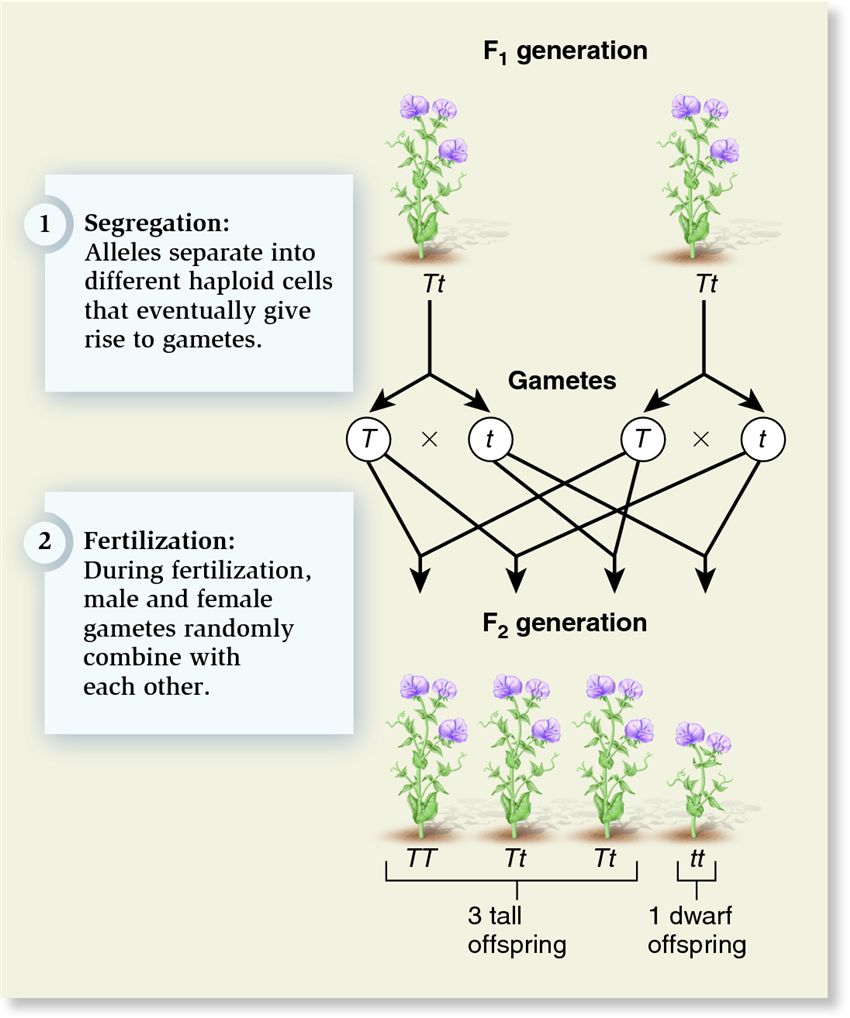 |
| Previous Image | Next Image |
| Description: The segregation of alleles in the F1 generation gives rise to gametes that carry just one of the two alleles. These gametes combine randomly during fertilization, producing the allele combinations TT, Tt, and tt in the F2 offspring. The combination Tt occurs twice as often as either of the other two combinations because it can be produced in two different ways. The TT and Tt offspring are tall, while the tt offspring are dwarf. Dominant and recessive traits. Perhaps the most surprising outcome of Mendel's work was that the data argued strongly against the prevailing notion of a blending mechanism of heredity. In all seven cases, the F1 generation displayed traits distinctly like one of the two parents rather than intermediate traits. By using genetic terms that Mendel originated, we describe the alternative traits as dominant and recessive. The term dominant describes a trait that is seen in both a true-breeding parent and in its F1 hybrid. While the term recessive describes a trait that is seen in a true-breeding parent but is masked in the F1 hybrid. Tall stems and green pods are examples of dominant traits; dwarf stems and yellow pods are examples of recessive traits. We say that tall is dominant over dwarf and green is dominant over yellow. Genes and alleles. Mendel's results were consistent with a particulate mechanism of inheritance, in which the determinants of traits are inherited as unchanging, discrete units. In all seven cases, the recessive trait reappeared in the F2 generation: some F2 plants displayed the dominant trait, while a smaller proportion showed the recessive trait. This observation led Mendel to conclude that the genetic determinants of traits are “unit factors†that are passed intact from generation to generation. These unit factors are now call genes, a term coined by the botanist Wilhelm Johannsen in 1911. Mendel postulated that every individual carries two versions of a gene for a given trait, and that the gene for each trait may have variant forms, which we now call alleles. For example, the gene controlling height in Mendel's pea plants occurs in two variants: the dominant tall allele that is associated with the tall trait and the recessive allele associated with the dwarf trait. The right side of Figure 15.5a shows Mendel's conclusions and uses genetic symbols (letters) that were adopted later. The letters T and t represent the alleles of the gene for plant height. By convention, the uppercase letter represents the dominant allele (in this case, tall) and the same letter in lowercase represents the recessive allele. Segregation of alleles. When Mendel compared the number of F2 offspring exhibiting dominant and recessive traits, he noticed a recurring pattern. Although some experimental variation occurred, he observed approximately a 3:1 ratio between the dominant and the recessive trait (Figure 15.5b). This observation allowed him to conclude that the two copies of a gene (alleles) carried by an F1 plant segregate (separate) from each other, so that each sperm or egg carries only one allele. The diagram in Figure 15.6 shows that segregation of the F1 alleles should result in equal numbers of gametes carrying the dominant allele (T) and the recessive allele (t). If these gametes combine randomly at fertilization, as shown in the figure, this would account for the 3:1 ratio of the F2 generation. Note that the genotype Tt can be produced by two different combinations of allelesâ€â€Âthe T allele can come from the male gamete and the t allele from the female gamete, or vice versa. This accounts for the fact that the Tt genotype is produced twice as often as either TT or tt. The idea that the two copies of a gene segregate from each other during transmission from parent to offspring is known today as Mendel's law of segregation of alleles. Picture Stats: Views: 4453 Filesize: 91.84kB Height: 1018 Width: 850 Source: https://biology-forums.com/index.php?action=gallery;sa=view;id=514 Keywords: How the law of segregation of alleles explains Mendel's observed ratios |
